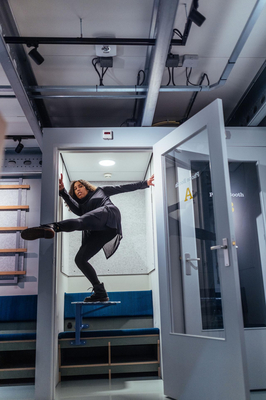#Team2 | Rebecca Wijnruit

"The instrument of gender expression are the same as the means of dance expression”
I'm looking forward to collaborating with my fellow art and society-program participants during the program! I'll research and (de)construct my individual thoughts and movements, concentrating on the interchange of art and society. I believe that my fellow residents can enrich me as a person and as an artist by fueling a collective fire due to sharing ideas, perspectives, enthusiasm, and having a collective purpose to create both alone and together artistic products that rely on one another. In that sense, the more we operate as a collective, a team, the more we can accomplish.”
The more we work together as a team, the more we can achieve
I believe in the inherent potential of connection and communication through movement and dance. I will be working on and exploring new material for new work while a resident at The Culture Club. Intrigued by the line: “The instrument of gender expression are the same as the means of dance expression”, it inspired me to research this topic in order to eventually communicate a meaning behind this phrase. Findings will be collected and documented as registration and content for dance on screen. Ultimately, the goal is to present the completed product/work to a (live) audience.
Interview with Rebecca
When she started doing hip-hop and street dance as a child, dancer Rebecca Wijnruit (27) knew it immediately: may this never end. ‘I had always loved sport, movement and music, and that all came together for me in dance. The wonderful feeling of searching for new dance forms to the accompaniment of music. The sensation of muscles that tighten and relax with each new form. Experiencing with the body instead of the brain. That is what I find in dance.’ Rebecca is now conducting research into her passion. As an alumna of the Academy of Theatre and Dance, she is occupied in the AHK Culture Club with the question of how gender possibly influences dance and dance education. ‘You have to deal with a lot of different energies in dance, including feminine and masculine. Dancers are particularly adept at playing with that. However, which assumptions and stereotypes precede that? With this research, I want to create a gateway to awareness of the possible relationship between dance and the (Western) social construction of gender and, if that exists, to explore how this relates to dancers and dance students. On the basis of that awareness, a method can be developed that recognises any conformism to that construction and in response to that will approach movement from a different, more dynamic perspective.’
‘Because conforming in dance has an irrevocable effect on how dance takes shape. With awareness, you may eventually create more freedom in the head of a dancer, so they are able to become even more familiar with their own body and use it better, without the restriction of any conformism. I don’t expect that my research will achieve all that, but I hope to offer a gateway to reflection that may ultimately lead to awareness.’
In the Culture Club, Rebecca found an environment where she could conduct her research in total freedom. ‘You are given all the building blocks you need here, but are stimulated above all to start building yourself. Because you work with teammates in the Art & Society programme, you learn how the others think and as a result of that you get to know better how you yourself think. I stepped outside my ‘dance bubble’ for the first time and I come into contact with alumni from other academies, and that is extremely beneficial. The Culture Club has turned out to be a learning experience for me, both personally and professionally.
(by: Sjoerd Ponstein)



